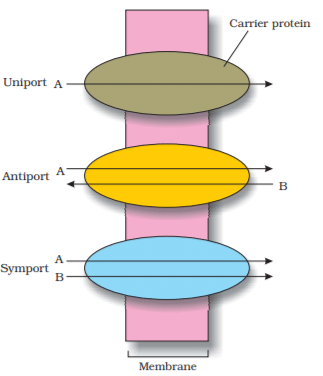Facilitated Diffusion | Biology for JAMB PDF Download
Facilitated Diffusion
As pointed out earlier, a gradient must already be present for diffusion to occur. The diffusion rate depends on the size of the substances; obviously smaller substances diffuse faster. The diffusion of any substance across a membrane also depends on its solubility in lipids, the major constituent of the membrane. Substances soluble in lipids diffuse through the membrane faster. Substances that have a hydrophilic moiety, find it difficult to pass through the membrane; their movement has to be facilitated. Membrane proteins provide sites at which such molecules cross the membrane. They do not set up a concentration gradient: a concentration gradient must already be present for molecules to diffuse even if facilitated by the proteins. This process is called facilitated diffusion.
In facilitated diffusion special proteins help move substances across membranes without expenditure of ATP energy. Facilitated diffusion cannot cause net transport of molecules from a low to a high concentration – this would require input of energy. Transport rate reaches a maximum when all of the protein transporters are being used (saturation).


Figure. Facilitated diffusion
Facilitated diffusion is very specific: it allows cell to select substances for uptake. It is sensitive to inhibitors which react with protein side chains. The proteins form channels in the membrane for molecules to pass through. Some channels are always open; others can be controlled. Some are large, allowing a variety of molecules to cross. The porins are proteins that form huge pores in the outer membranes of the plastids, mitochondria and some bacteria allowing molecules up to the size of small proteins to pass through. Figure shows an extracellular molecule bound to the transport protein; the transport protein then rotates and releases the molecule inside the cell, e.g., water channels – made up of eight different types of aquaporins.
Passive symports and antiports
Some carrier or transport proteins allow diffusion only if two types of molecules move together. In a symport, both molecules cross the membrane in the same direction; in an antiport, they move in opposite directions (Figure ). When a molecule moves across a membrane independent of other molecules, the process is called uniport.

|
225 videos|175 docs|156 tests
|
FAQs on Facilitated Diffusion - Biology for JAMB
| 1. What is facilitated diffusion? |  |
| 2. How does facilitated diffusion differ from simple diffusion? |  |
| 3. What are the transport proteins involved in facilitated diffusion? |  |
| 4. Can facilitated diffusion transport substances against their concentration gradient? |  |
| 5. What factors can affect the rate of facilitated diffusion? |  |





















